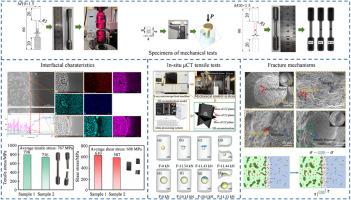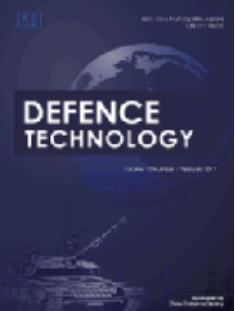TA15/TaZrNb multi-element alloy prepared via diffusion bonding: Tensile-strength model and performance of a representative volume element embedded with a sphere
IF 5.9
Q1 ENGINEERING, MULTIDISCIPLINARY
引用次数: 0
Abstract
In this study, to meet the development and application requirements for high-strength and high-toughness energetic structural materials, a representative volume element of a TA15 matrix embedded with a TaZrNb sphere was designed and fabricated via diffusion bonding. The mechanisms of the microstructural evolution of the TaZrNb/TA15 interface were investigated via SEM, EBSD, EDS, and XRD. Interface mechanical property tests and in-situ tensile tests were conducted on the sphere-containing structure, and an equivalent tensile-strength model was established for the structure. The results revealed that the TA15 titanium alloy and joint had high density and no pores or cracks. The thickness of the planar joint was approximately 50–60 μm. The average tensile and shear strengths were 767 MPa and 608 MPa, respectively. The thickness of the spherical joint was approximately 60 μm. The Zr and Nb elements in the joint diffused uniformly and formed strong bonds with Ti without forming intermetallic compounds. The interface exhibited submicron grain refinement and a concave–convex interlocking structure. The tensile fracture surface primarily exhibited intergranular fracture combined with some transgranular fracture, which constituted a quasi-brittle fracture mode. The shear fracture surface exhibited brittle fracture with regular arrangements of furrows. Internal fracture occurred along the spherical interface, as revealed by advanced in-situ X-ray microcomputed tomography. The experimental results agreed well with the theoretical predictions, indicating that the high-strength interface contributes to the overall strength and toughness of the sphere-containing structure.

扩散键合法制备TA15/TaZrNb多元素合金:球面嵌套代表性体积元的抗拉强度模型及性能
本研究为满足高强度、高韧性含能结构材料的发展和应用需求,通过扩散键合的方法,设计并制备了TA15基体中嵌入TaZrNb球的具有代表性的体积元。通过SEM、EBSD、EDS、XRD等手段研究了TaZrNb/TA15界面微观结构演变的机理。对含球结构进行了界面力学性能试验和原位拉伸试验,建立了含球结构的等效拉伸强度模型。结果表明:TA15钛合金及其接头密度高,无气孔和裂纹;平面接头厚度约为50 ~ 60 μm。平均抗拉强度为767 MPa,抗剪强度为608 MPa。球形接头的厚度约为60 μm。Zr和Nb元素在接头中均匀扩散,与Ti形成强键,不形成金属间化合物。界面呈现亚微米级晶粒细化和凹凸互锁结构。拉伸断口以沿晶断裂为主,并伴有部分穿晶断裂,呈准脆性断裂模式。剪切断裂面呈脆性断裂,沟槽排列规则。通过先进的原位x射线微计算机断层扫描显示,内部断裂沿球面界面发生。实验结果与理论预测吻合较好,表明高强界面对含球结构的整体强度和韧性有较大贡献。
本文章由计算机程序翻译,如有差异,请以英文原文为准。
求助全文
约1分钟内获得全文
求助全文
来源期刊

Defence Technology(防务技术)
Mechanical Engineering, Control and Systems Engineering, Industrial and Manufacturing Engineering
CiteScore
8.70
自引率
0.00%
发文量
728
审稿时长
25 days
期刊介绍:
Defence Technology, a peer reviewed journal, is published monthly and aims to become the best international academic exchange platform for the research related to defence technology. It publishes original research papers having direct bearing on defence, with a balanced coverage on analytical, experimental, numerical simulation and applied investigations. It covers various disciplines of science, technology and engineering.
 求助内容:
求助内容: 应助结果提醒方式:
应助结果提醒方式:


